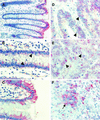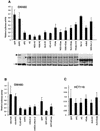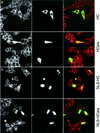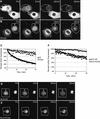Nuclear export of the APC tumour suppressor controls beta-catenin function in transcription
- PMID: 12606575
- PMCID: PMC150338
- DOI: 10.1093/emboj/cdg105
Nuclear export of the APC tumour suppressor controls beta-catenin function in transcription
Abstract
The adenomatous polyposis coli (APC) protein is inactivated in most colorectal tumours. APC loss is an early event in tumorigenesis, and causes an increase of nuclear beta-catenin and its transcriptional activity. This is thought to be the driving force for tumour progression. APC shuttles in and out of the nucleus, but the functional significance of this has been controversial. Here, we show that APC truncations are nuclear in colorectal cancer cells and adenocarcinomas, and this correlates with loss of centrally located nuclear export signals. These signals confer efficient nuclear export as measured directly by fluorescence loss in photobleaching (FLIP), and they are critical for the function of APC in reducing the transcriptional activity of beta-catenin in complementation assays of APC mutant colorectal cancer cells. Importantly, targeting a functional APC construct to the nucleus causes a striking nuclear accumulation of beta-catenin without changing its transcriptional activity. Our evidence indicates that the rate of nuclear export of APC, rather than its nuclear import or steady-state levels, determines the transcriptional activity of beta-catenin.
Figures








Similar articles
-
Nuclear accumulation of full-length and truncated adenomatous polyposis coli protein in tumor cells depends on proliferation.Oncogene. 2003 Sep 4;22(38):6013-22. doi: 10.1038/sj.onc.1206731. Oncogene. 2003. PMID: 12955080
-
Nuclear-cytoplasmic shuttling of APC regulates beta-catenin subcellular localization and turnover.Nat Cell Biol. 2000 Sep;2(9):653-60. doi: 10.1038/35023605. Nat Cell Biol. 2000. PMID: 10980707
-
The beta-catenin binding domain of adenomatous polyposis coli is sufficient for tumor suppression.Cancer Res. 2000 Mar 15;60(6):1671-6. Cancer Res. 2000. PMID: 10749138
-
Nuclear accumulation of beta-catenin without an additional somatic mutation in coding region of the APC gene in hepatoblastoma from a familial adenomatous polyposis patient.Oncol Rep. 2004 Jan;11(1):121-6. Oncol Rep. 2004. PMID: 14654913 Review.
-
The APC gene product and colorectal carcinogenesis.C R Acad Sci III. 1996 Oct;319(10):861-9. C R Acad Sci III. 1996. PMID: 8977766 Review.
Cited by
-
kin-19/casein kinase Iα has dual functions in regulating asymmetric division and terminal differentiation in C. elegans epidermal stem cells.Cell Cycle. 2010 Dec 1;9(23):4748-65. doi: 10.4161/cc.9.23.14092. Epub 2010 Dec 1. Cell Cycle. 2010. PMID: 21127398 Free PMC article.
-
Absence of DAB2IP promotes cancer stem cell like signatures and indicates poor survival outcome in colorectal cancer.Sci Rep. 2015 Nov 13;5:16578. doi: 10.1038/srep16578. Sci Rep. 2015. PMID: 26564738 Free PMC article.
-
Adenomatous polyposis coli in cancer and therapeutic implications.Oncol Rev. 2021 Jun 24;15(1):534. doi: 10.4081/oncol.2021.534. eCollection 2021 Feb 26. Oncol Rev. 2021. PMID: 34267890 Free PMC article.
-
A novel mutation of adenomatous polyposis coli (APC) gene results in the formation of supernumerary teeth.J Cell Mol Med. 2018 Jan;22(1):152-162. doi: 10.1111/jcmm.13303. Epub 2017 Aug 7. J Cell Mol Med. 2018. PMID: 28782241 Free PMC article.
-
BCL9/9L-β-catenin Signaling is Associated With Poor Outcome in Colorectal Cancer.EBioMedicine. 2015 Oct 30;2(12):1932-43. doi: 10.1016/j.ebiom.2015.10.030. eCollection 2015 Dec. EBioMedicine. 2015. PMID: 26844272 Free PMC article.
References
-
- Behrens J., Jerchow,B.A., Wurtele,M., Grimm,J., Asbrand,C., Wirtz,R., Kuhl,M., Wedlich,D. and Birchmeier,W. (1998) Functional interaction of an axin homolog, conductin, with β-catenin, APC and GSK3β. Science, 280, 596–599. - PubMed
-
- Bienz M. (1999) APC: the plot thickens. Curr. Opin. Genet. Dev., 9, 595–603. - PubMed
-
- Bienz M. (2002) The subcellular destinations of APC proteins. Nat. Rev. Mol. Cell Biol., 3, 328–338. - PubMed
Publication types
MeSH terms
Substances
LinkOut - more resources
Full Text Sources
Miscellaneous

